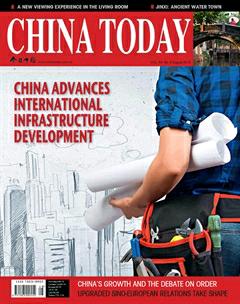Sustaining the Green Drive
By+TOSHIHIKO+INOUE
DESERTIFICATION has be- come a threat to the whole planet, jeopardizing economy and society. But for us Japanese, who live on islands and are, therefore, never short of water, desertification is not an issue we are familiar with. But still, in recent years, we have encountered sand storms in spring.
During the Kubuqi Forum, I witnessed a frank dialogue between researchers from Pakistan, Turkey, Australia, Uzbekistan, Tunisia, and Chile and young journalists from Beijing. The former elaborated on their respective countries specific measures in combating desertification in the manner of teachers, which I found illuminating and impressive.
These experts stressed that desertification is a highly complicated issue and cannot be reversed by volunteers planting more trees or by the developed countries providing funds and technologies. But it is not a death sentence for the planet: People around the world have developed the wisdom to live with it and even created a unique desert culture.
The attention these experts paid to the young journalists betrayed the expectations they place on the young generation. The climate issue is a long-term one, and its solution demands efforts for generations to come.
The younger participants at the forum showed great concern over the the climate issue. Some presented substantive proposals. The youngest of them was Cai Yuanming, a student attending high school in North Carolina. In his speech, the 18-year-old underlined the importance of education on climate and called for closer cooperation among relevant international organizations. He told me that his interest in the issue is attributable to his father, who worked on environmental protection and international exchanges. He hoped to work for an international organization someday, so decided to study abroad. Besides the U.S. he had spent one month in Japan. This young generation of Chinese people with broader global visions promise a brighter future for their country.
At the forum I watched a news broadcast about illegal sand excavation in the Poyang Lake in Jiangxi Province, and thought to myself: “They can take as much sand as they want from here.” I know the sands in the desert are not fit for building materials, but still wonder if it is possible to turn them into something useful. Later, I was introduced to some businesses trying to extract value from the barren desert.endprint
Elion Group is one of them. Over the past 27 years the group chairman, Wang Wenbiao and his team have turned 6,000 sq km of desert green, and devel- oped solar energy, eco-farming of livestock, pharmaceuticals, and tourism in the formerly lifeless area.
Some other reporters and I visited one site of the companys afforestation operation. After a 30-minute drive from the forum venue, we arrived at the Hero Slope in the Kubuqi Desert. Shang Youfu, aged 58, was pressing a metal pipe into the ground and pumping water into it. Another worker inserted a tree seedling in the hole the pipe produced. In this way about 1.3 hectares of desert can be covered in trees every day, and the survival rate is as high as 90 percent.
Shang told me, with a broad smile, that his second son was doing the same job. Like the tender seedlings, the successors to Chinas green drive are also growing and thriving.
The vegetation planted in the desert has commercial value. Inner Mongolia Yili Kangmu Biotechnology Co., Ltd has worked on transforming desert plants into animal feed. Under the leadership of its general manager Wang Guoguang, the company launched the research in 2000, and has developed organic feed based on desert plants.
The ancient Silk Road, which consists of large expanses of desert, is becoming greener. And more people are now involved in the green drive. Some years later the term Silk Road may invoke the image of oases in the minds of Japanese people.endprint
- CHINA TODAY的其它文章
- Initiating a New Partnership Between China and Developed Countries
- China and Advanced Economies–A Win-Win Relationship
- Fangshan’s Wineries and Ecological Practices
- Sustainable Development Mode on the“Roof of the World”
- “We Must Grasp the Opportunity that Paris Offers”
- Face History and Maintain Peace

